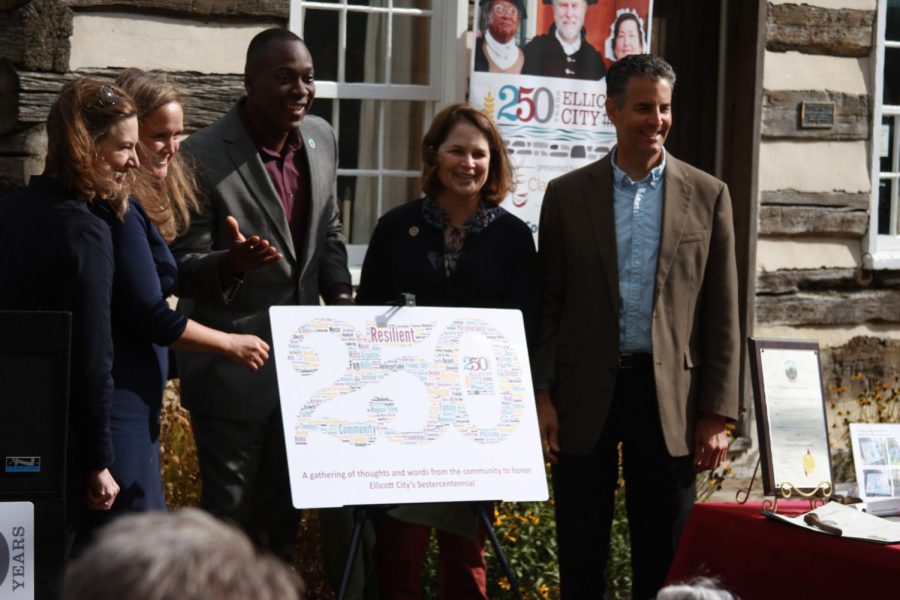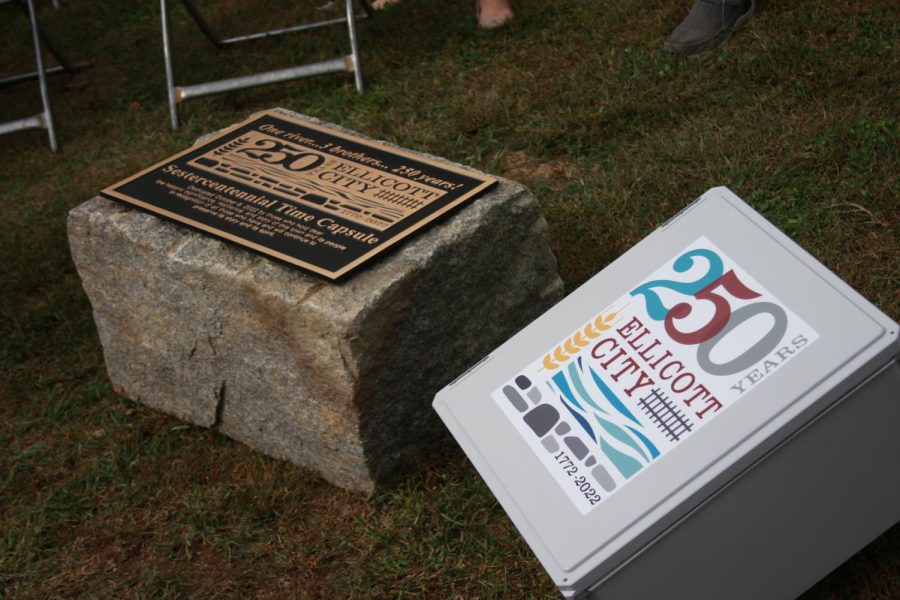Out And About: The Ellicott City Sestercentennial
250 Years & Counting
October 13, 2022
It’s a crisp fall morning in the old main street of Ellicott City, a town that has survived numerous floods and the changes and woes of the country it barely preceded. I stand in front of the Thomas Isaac log cabin, a historic structure from the town’s founding that now greets the noisy traffic along the Main Street. Here, a ceremony is being held for a time capsule in celebration of the town’s anniversary, planned not to be opened until its next major anniversary, in front of a rather small but proud crowd, with a table filled with artifacts and memorabilia relating to the celebrations sitting out on display. The master of ceremonies steps up to the podium, and the event begins.
She introduces the various speakers, who each regale us with their own personal thoughts on the town. James Robey, a former police chief, county executive, and state senator of the area, tells us about his personal history with the town in childhood. Current county executive Calvin Ball, among other incumbent politicians representing the town, highlights its resilience and historic meaning. Linda Joy Burkes, a local artist, reads out her winning submission for a poetry contest held as part of the town’s celebrations, relating to an artifact and the town’s historic black community of Fells Lane. Finally, the time capsule itself is unveiled, as well as a stone, taken from the town’s old courthouse, which shall mark the spot once the capsule is finally buried.
The ceremony concludes with a musical number dedicated to the town’s history, and that is that. I lay my eyes on the items to be buried, before finally leaving, presumably never to see them again in person, unless, God willing, I manage to return in 50 years to its opening. A time when I’ll be a decrepit, likely confused 72-year-old, laying eyes on items I last saw when I was a young, semi-confused 22-year-old.
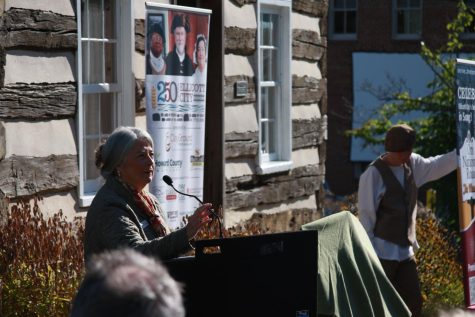
This event was but one of many others hosted throughout 2022 as part of my hometown’s sestercentennial, or 250th anniversary. These celebrations were organized by EC250, Inc., a non-profit endeavor from residents and local organizations to commemorate the town and its story over the past 250 years, and encourage others to learn about it.
For those unfamiliar, Ellicott City is the neighboring community of Columbia to its north, as well as the county seat of Howard County. Its distinct sections are between the old core of the town, or “Old Ellicott City,” nestled in a river valley between steep, rocky hills and situated next to the Patapsco river, and the wider, “newer” town that stretches between Route 40 and 108.
To regale a bit of its history, which can be partly found on the official website for the celebration, Ellicott City was originally founded as Ellicott Mills in 1772, nestled between the hills of the Patapsco River. Three brothers—John, Andrew and Joseph Ellicott—arrived to the site from Pennsylvania for none other than milling and making use of the Patapsco’s flowing waters. In the course of its 250 year history, it has been a junction of some of America’s first major infrastructure works. The first federally-commissioned highway, the National Road, runs through the town in what is now its Main Street and Frederick Road. The Baltimore & Ohio (B&O) Railroad Company laid the nation’s first railroad in 1830 over that National Road, with its first station located in Ellicott Mills and still standing as the nation’s oldest surviving train station. Several floods devastated the town over the years, including the recent ones in 2016 and 2018 that overran many businesses. Nevertheless, the town has managed to survive, thrive, grow and transform.
“The fact of the matter that the Ellicotts actually founded this area, which was pretty much a wilderness, and within 35 to 40 years, this was a town of 3,000 people, is pretty amazing, and reflective of an early move to industrialization,” said Ellen Giles, president of the Howard County Historical Society, one of the organizations that formed EC250. The use of modern milling techniques and shift from production of tobacco to wheat “changed the nature of the economy in the Mid-Atlantic states, especially in this part of Maryland,” she told me, and alongside the construction of the National Road and railroads, both marked the state’s and America’s transition from large, slave-holding cash crops as a major part of their economies, and instead food and industrial production. “It is about the growth of America, from Revolution to Civil War.”
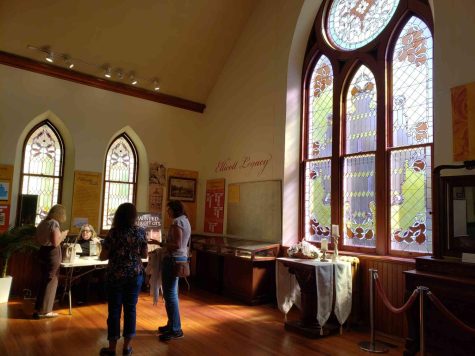
The celebrations are hoped to bring wider attention to groups in its history which had often been left out. Freedman and historic surveyor Benjamin Banneker, who had been living in the area before the Ellicotts settled the area and had already been a rather notable figure of the town, has received a greater push as a major part of its history, alongside the historic black community of Fells Lane that once stood by the town, as commemorated in Linda Joy Burkes poem. Attention has also been brought to the Native American communities that once occupied the area. A copy of a land acknowledgement statement from the EC250 organization, noting the use of the land by these peoples, was placed within the time capsule as well. Later that day, a luncheon with members of the Miami tribe, which once occupied the area, was held at the Miller Branch Library.
Suffice it to say, Ellicott City has a long history worth learning, and the anniversary is believed to be a key celebration. On a more sentimental level, however, the anniversary may be viewed as a vital opportunity in a significant moment. In the wake of the past decade—a time in which the town suffered two floods and a global pandemic, and the nation itself has been rocked by racial reckoning and divisive figures—a triumph like this, reflecting on how the town has survived and thrived through these difficulties, serves as a reminder for how we shall keep moving forward.
“Throughout the pandemic, we’ve been reminded of our challenges,” Howard County Executive Calvin Ball said at the time capsule dedication ceremony. “We have faced so much time of fear, anxiety, but ever-present, much like in Pandora’s Box, there was hope. And when we have a time capsule that commemorates 250 years, right here in Ellicott City, a place that has seen so much challenge, anxiety, but also ever-present hope, it reminds us that there will be better and brighter tomorrows.” Later, Ball and other government representatives helped unveil a community word cloud image, composed of words gathered from the community which they used to describe the town forming the number 250. The largest and most common one: “resilient.”
As it is now October, my coverage comes rather late, but if you are interested in celebrating or just learning about the town, there are still a few events, ongoing or upcoming, that residents or those nearby may attend, which can be found on the EC250 website. In ongoing events, two locations in the heart of Old Ellicott City present exhibits chronicling Ellicott City’s history up to the end of the year. The Howard County Museum of History hosts an Ellicott Legacy Exhibit, which, as the website says, “takes a look into the lives of Ellicott City’s founding family through the lens of its extensive Ellicott family artifact collection.” Nearby, the Howard County Welcome Center shows a wider history of the town with the Mill Town to City Exhibit, spotlighting its transformation into the town it is today. If you happen to be visiting Baltimore, you can also learn about the town at the Maryland Museum of History & Culture with its own exhibit, Resilient: 250 Years of Ellicott City, which illustrates the town’s evolution and struggles through select gallery displays.
For more special one-day affairs, a few commemorations and occasions are on the horizon. The aforementioned time capsule dedication ceremony was the most recent of these, held Oct. 8 at 10am. The items are planned to be sealed and buried beneath a spot at the location of the dedication ceremony, and will not be opened for 50 years until 2072, during the town’s tricentennial. Among some of the other objects placed within the time capsule were commemorative memorabilia like ornaments and postcards, a “Visit Howard County” guide from this year, a part of the railing from the Howard House, a collection of messages from local teens and a print of “Trolley at Fels Lane” by resident artist Wiley Purkey.
Another commemorative event for the near future, a “digitization day” with the Howard County Historical Archives at the Miller Branch Library, encourages anyone with a piece of Ellicott City history to bring their artifacts to the archives so as to preserve them for posterity.
The most intriguing of these events, however, is what’s planned for December, the cap off to the sestercentennial festivities and apparently the “signature event”—a theater show called “On National Road: The Musical.” As the title indicates, it is indeed an original musical show, telling the story of the town through dance and tunes, featuring “19 songs in a variety of musical genres.” The song, “Sing Me a Memory,” which was performed at the time capsule dedication ceremony, is one of these tunes. As the EC250 website notes:
The musical tells the story of significant people and events in the history of Ellicott City and Howard County when a family inadvertently opens a portal through time at Grandma and Pops’ in Ellicott City! Pieces of days-gone-by explode into the room and figures from the past dance across the floor. The walls reverberate in song as Charles Carroll of Carrollton, The Ellicotts, Benjamin Banneker and even Babe Ruth tell their stories.
The idea of creating an entire musical show to chronicle a town’s history is rather wild, but it’s certainly eye-catching. The performance is set to take place Dec. 8-11 and Dec. 16-17 at HCC’s very own Smith Theater in the Horowitz Visual & Performing Arts Center. Tickets are available now, so if you’re a fellow student reading this, you could very well purchase a ticket now and see Banneker and the Ellicotts breaking it down on stage after studies.
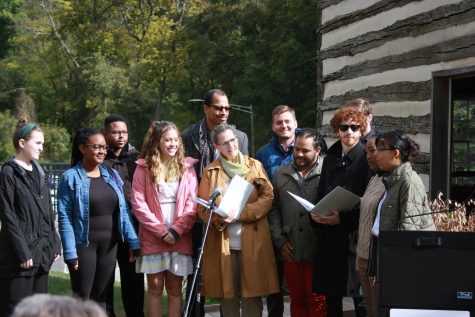
If you can’t find the time to attend any of these, or if the idea of Babe Ruth possibly jumping around and doing splits doesn’t take your fancy, there are plenty of interesting locations to visit to learn about Ellicott City on your own time, such as the B&O Ellicott City Station Museum or the Benjamin Banneker Historical Park & Museum. Or simply celebrate by paying Main Street a visit and exploring the nearby shops and sights.
So often, we may ignore localities these days, when much of our attention comes either in our immediate vicinity or the world at large. But exploring places like Ellicott City, through history or community, can offer so much, representing struggling and succeeding through tough times and decades of change, or simply providing unique and captivating perspectives to learn about. After all, how many other communities can say their residents decided to make a musical about their town?
In time, like the items of the time capsule, Ellicott City’s sestercentennial festivities will be a thing of the past—even as the town will, with all hope, keep standing.

